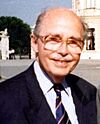Paneuropean Union facts for kids

The stars from the flag of Europe have been added to the Paneuropean flag in 1955.
|
|

Original flag (1922)
|
|
| Abbreviation | PEU |
|---|---|
| Formation | 1923 |
| Type | International organisation |
| Legal status | NGO |
| Purpose | European unification movement |
| Headquarters | Strasbourg |
| Location | |
|
Region served
|
Europe |
|
President
|
Alain Terrenoire (2004–) |
|
Main organ
|
General Assembly |
The International Paneuropean Union, also referred to as the Pan-European Movement and the Pan-Europa Movement, is an international organisation and the oldest European unification movement. It began with the publishing of Richard von Coudenhove-Kalergi's manifesto Paneuropa (1923), which presented the idea of a unified European State. The Union's General Secretariat is located in Munich, but maintains branches across Europe.
Since 2004, the President of the Union is Alain Terrenoire, former Member of Parliament in France and MEP and Director of the French Paneuropa-Union. Otto Habsburg became the International Honorary President of the International Paneuropean Union in 2004. The current vice president is Walburga Habsburg Douglas, a former member of the Swedish Parliament.
History

Coudenhove-Kalergi, a member of the Bohemian Coudenhove-Kalergi family and the son of an Austro-Hungarian diplomat and a Japanese mother, was the organisation's central figure and President until his death in 1972.
As French prime minister and follower of the Paneuropean Union Aristide Briand (Nobel Peace Prize laureate for the Locarno Treaties) delivered a widely recognized speech at the League of Nations in Geneva on 5 September 1929 for a federal Europe to secure Europe and settle the historic Franco-German enmity.
The organisation was prohibited by Nazi Germany in 1933, and was founded again after the Second World War. Winston Churchill lauded the movement's work for a unified Europe prior to the war in his famous Zurich speech in 1946. The French branch was founded by Georges Pompidou and Louis Terrenoire, subsequently French President and Minister for Information respectively, with the support of Charles de Gaulle. Otto von Habsburg, the head of the Habsburg dynasty and former Crown Prince of Austria-Hungary, became involved with the Paneuropean Union in the 1930s, was elected its Vice President in 1957 and became its International President in 1973, after Coudenhove's death.
The organisation was much reviled by the communist regimes of the Eastern Bloc. The organisation became renowned for its role in organising the Pan-European Picnic, an important event during the Revolutions of 1989.
As of 2023, the Paneuropean Union Parliamentary Group in the European Parliament consists of over 120 members from nearly all of the EU Member States and meets regularly during the sessions of the Parliament in Strasbourg.
Ideology
The organisation believes in a strong, politically and militarily, united Europe while supporting humanist and Christian values. The EPU is committed to uniting the diverse peoples of Europe, promoting peace, liberty, and rule of law, and for developing stronger democracy and human rights across Europe. The organisation supports the enlargement of the European Union and encourages all European countries to gain full EU membership. The EPU advocates the EU to become an independent, self-sufficient, and peaceful superpower. The EPU also believes in maintaining a European Common Security and Defence Policy, and establishing a European army alongside strong cooperation with NATO.
Member organisations
As of July 2023, the Paneuropean Union consists of member organizations in 32 countries across Europe:
Presidents
| No. | Image | Name | Term | Notes |
|---|---|---|---|---|
| 1 |  |
Count Richard von Coudenhove-Kalergi |
1923–1972 | Elected the first International President in 1926 |
| 2 |  |
Otto von Habsburg, MEP | 1973–2004 | Former Crown Prince Otto of Austria-Hungary |
| 3 |  |
Alain Terrenoire | 2004–present | Former Member of Parliament and MEP, France |
Individual members
The Paneuropean Union lists the following as historical members:
- Konrad Adenauer
- Raymond Barre
- Léon Blum
- Aristide Briand
- Paul Claudel
- Benedetto Croce
- Albert Einstein
- Sigmund Freud
- Charles de Gaulle
- Alfons Goppel
- Otto von Habsburg
- Gerhart Hauptmann
- Bronisław Huberman
- Bruno Kreisky
- Paul Löbe
- Salvador de Madariaga
- Heinrich Mann
- Thomas Mann
- Johan Ludwig Mowinckel
- Fridtjof Nansen
- José Ortega y Gasset
- Georges Pompidou
- Rainer Maria Rilke
- Arthur Schnitzler
- Kurt Schuschnigg
- Franz Josef Strauß
- Richard Strauss
- Gustav Stresemann
- Paul Valéry
- Franz Werfel
- Stefan Zweig
See also
 In Spanish: Unión Internacional Paneuropea para niños
In Spanish: Unión Internacional Paneuropea para niños
- European integration – mainly through the European Union and the Council of Europe
- Euroscepticism – opposition to the process of political European integration
- PanEuropa Armenia – the Armenian branch of Paneuropean Union
- Pan-European identity
- Politics of Europe
- Pro-Europeanism
- United States of Europe

